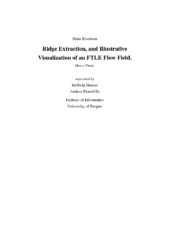Ridge Extraction, and Illustrative Visualization of an FTLE Flow Field.
Master thesis
Permanent lenke
https://hdl.handle.net/1956/15843Utgivelsesdato
2012-06-01Metadata
Vis full innførselSamlinger
Sammendrag
Illustrative visualization of a flow is an area that is proving to be interesting and in later years something that have been somewhat explored, it can provide some very interesting results and in this thesis we find the required structures needed for such a visualization. Lagrangian coherent structures are now commonly used in flow visualization and we establish a simplistic approach to creating them in this thesis. The problem of occlusion and the general complexity of both the data and the visual results are still a common thing when working with a structured flow. This thesis presents a solution that identifies the complex and often large amounts of data that is inherent in a flow and tries to find a good way of extracting the structures within. By using the FTLE values found in the flow data we define these structures so that we can see what is going on in these complex systems, as well as combining it with an illustrative approach that will provide an interesting visual aspect to the integral structures found in flows. By using mathematical analysis of the raw data we obtain the necessary tools we need to define and extract ridges that form LCS that we can then model. We use a simple approach by focusing on the basic components of such complex structures as well as utilizing often long standing principles in an interesting way. Combining the strengths of both illustrative visualization and the clarity of integral structures we can create a more visual sound model that loses some of its cluttering complexities but is still capable of generating a pleasing visual end result.
